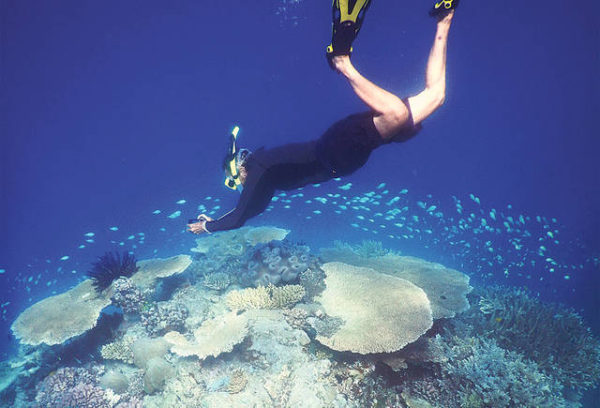Published in the Ocean Watch column, Honolulu Star-Advertiser © Susan Scott
November 11, 2017
Since I returned from Australia last week, people have been asking what I think about coral reef bleaching. Do I believe humans are causing it, and, if so, can we fix it?
 Many scientists believe that the Earth is headed for a sixth wave
Many scientists believe that the Earth is headed for a sixth wave
of mass extinctions, with humans rushing the rate. Corals will be
among those affected, but one small sign of encouragement is
that some corals are adapting to changing conditions.
Susan Scott snorkels off Kelso Reef, Australia.
Courtesy Craig Thomas
The questions refer to reports of corals turning white in areas of Australia’s Great Barrier Reef, and other reports about Hawaii’s reefs. Between 2014 and 2015, scientists found bleaching in 56 percent of corals off the Big Island, 44 percent off West Maui and 32 percent around Oahu.
So-called bleaching occurs when overly warm ocean water causes corals to ditch their algae. The corals’ clear bodies then expose the white calcium carbonate cups that support them.
Researchers theorize that this occurs because overheating causes the plants to make more oxygen, and too much of the gas creates free radicals, a single O instead of the usual O2. Lone oxygen atoms are toxic to animal cells.
The good news is that bleached coral isn’t necessarily dead coral. A coral can live for a while without its plants because its tentacles sting and eat passing animal plankton. When the water later cools, such as after El Nino years, live bleached corals catch algae drifting past in the water. When the plants multiply, they put the color back in corals’ cheeks.
Because bleached corals eventually need carbs, however, if the water stays warm, the corals can’t replenish their crops and die.
This isn’t the first time on Earth that corals have been in trouble. The first reefs formed 490 million years ago, and since then five mass extinctions caused by asteroids, climate change, volcanoes and sometimes more subtle changes killed all reef-building corals. The extinctions took 1 million to 2 million years each, and hundreds of millions of years for new species to evolve.
Most scientists believe we’re on the verge of a sixth extinction. The difference this time is that we humans are rushing the rate. What would normally take 140,000 years for a species to disappear now takes 100.
Homo sapiens is one of those species. In their bright white way, reef-building corals are our putting us on red alert. We are paving the road to our own extinction.
I doubt we humans will mend our ways in time. Our animal instincts to reproduce, fight, and segregate families and tribes from one another make uniting for a common cause tough.
But because species evolve to changing conditions, there’s hope. Some corals are adapting to higher water temperatures and doing just fine. Perhaps, as human and wildlife suffering escalates worldwide, our species will evolve to become less selfish.
In the meantime, there’s tremendous beauty left on the planet, and we should get out there and enjoy it. And who knows? By each of us volunteering to the charity of our choice, we may be accelerating our species’ evolution to altruism.